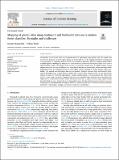Files in this item
Mapping of glacial lakes using Sentinel-1 and Sentinel-2 data and a random forest classifier : strengths and challenges
Item metadata
| dc.contributor.author | Wangchuk, Sonam | |
| dc.contributor.author | Bolch, Tobias | |
| dc.date.accessioned | 2020-08-10T14:30:01Z | |
| dc.date.available | 2020-08-10T14:30:01Z | |
| dc.date.issued | 2020-12 | |
| dc.identifier.citation | Wangchuk , S & Bolch , T 2020 , ' Mapping of glacial lakes using Sentinel-1 and Sentinel-2 data and a random forest classifier : strengths and challenges ' , Science of Remote Sensing , vol. 2 , 100008 . https://doi.org/10.1016/j.srs.2020.100008 | en |
| dc.identifier.issn | 2666-0172 | |
| dc.identifier.other | PURE: 269365148 | |
| dc.identifier.other | PURE UUID: c9a518b9-616e-4c37-afb1-dd84972d1276 | |
| dc.identifier.other | RIS: urn:D1018DB9F9480332E505A71E0132CD22 | |
| dc.identifier.other | ORCID: /0000-0002-8201-5059/work/78205130 | |
| dc.identifier.other | Scopus: 85092355955 | |
| dc.identifier.uri | https://hdl.handle.net/10023/20441 | |
| dc.description | Sonam Wangchuk acknowledges ESKAS - Swiss Government Excellence Scholarship for Foreign Scholars, Swiss Polar Institute, and University of Zurich for supporting the research. Tobias Bolch thanks the Swiss National Science Foundation [IZLCZ2_169979/1]. | en |
| dc.description.abstract | Glacial lakes pose a serious threat to downstream areas and significantly impact glacier melt. The number and area of lakes has grown in most regions during the last decades due to the ongoing atmospheric warming and retreating glaciers. It is therefore important to identify and monitor these lakes. However, mapping of glacial lakes in alpine regions is challenged by many factors. These factors include small size of glacial lakes, cloud cover in optical satellite images, cast shadows from mountains and clouds, seasonal snow in satellite images, varying degrees of turbidity amongst glacial lakes, and frozen glacial lake surface. In our study, we have developed a fully automated method for mapping glacial lake across alpine regions including the Python package called “GLakeMap”. The method uses multi-source data such as Sentinel-1 Synthetic Aperture Radar and Sentinel-2 Multi-spectral Instrument data, digital elevation model, and a random forest classifier model. We use multi-source datasets as inputs for rule-based segmentation of images, mainly aiming at extracting glacial lake objects from satellite images using a set of rules. Segmented objects are then classified either as glacial lake or non-glacial lake objects by the random forest classifier model. The method was tested in eight sites across alpine regions mainly located in High Mountain Asia but also in the Alps and the Andes. We show that the proposed method overcomes a majority of the aforementioned challenges to detect and delineate glacial lakes. The method performs efficiently irrespective of geographic, geologic, and climatic conditions of glacial lakes. | |
| dc.language.iso | eng | |
| dc.relation.ispartof | Science of Remote Sensing | en |
| dc.rights | Copyright © 2020 The Author(s). Published by Elsevier B.V. This is an open access article under the CC BY-NC-ND license (http://creativecommons.org/licenses/by-nc-nd/4.0/). | en |
| dc.subject | Sentinel-1 | en |
| dc.subject | Synthetic aperture radar (SAR) | en |
| dc.subject | Radar backscatter | en |
| dc.subject | Sentinel-2 | en |
| dc.subject | Normalised difference water index | en |
| dc.subject | Image segmentation | en |
| dc.subject | Random forest | en |
| dc.subject | Glacial lake mapping | en |
| dc.subject | Alpine | en |
| dc.subject | G Geography (General) | en |
| dc.subject | NDAS | en |
| dc.subject.lcc | G1 | en |
| dc.title | Mapping of glacial lakes using Sentinel-1 and Sentinel-2 data and a random forest classifier : strengths and challenges | en |
| dc.type | Journal article | en |
| dc.description.version | Publisher PDF | en |
| dc.contributor.institution | University of St Andrews. School of Geography & Sustainable Development | en |
| dc.contributor.institution | University of St Andrews. Environmental Change Research Group | en |
| dc.contributor.institution | University of St Andrews. Bell-Edwards Geographic Data Institute | en |
| dc.identifier.doi | https://doi.org/10.1016/j.srs.2020.100008 | |
| dc.description.status | Peer reviewed | en |
This item appears in the following Collection(s)
Items in the St Andrews Research Repository are protected by copyright, with all rights reserved, unless otherwise indicated.

